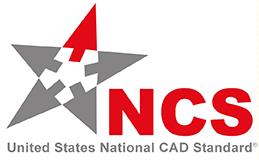United States National CAD Standard® Content
Voluntary adoption of the Standard across the industry will improve the efficiency of building design, construction, and management throughout the life-cycle of facilities. Adoption will benefit architects, engineers, contractors, and building owners by establishing a common language for the building design and documentation process. Implementation of the NCS eliminates overhead costs that many organizations now incur trying to maintain proprietary office standards, training new staff in their use, and coordinating proprietary office formats among various design consultants.
The United States National CAD Standard (NCS) version 6 is comprised of the Foreword, Administration, AIA CAD Layer Guidelines, Uniform Drawing System, BIM Implementation, Plotting Guidelines and Appendixes.
The following are sample pages from each module of the standard (Adobe Acrobat PDFs):
Foreword and Administration
The foreword and administration provides a brief history of the development of the NCS and the process for its future evolution and development.
AIA CAD Layer Guidelines
These guidelines discuss layer name format, and provide exhaustive layer lists for over twenty types of layers. The Layer module includes new layers for distributed energy, real estate, survey/mapping, architectural, structural, architectural, fire protection, electrical, plumbing, mechanical, and telecommunications.
Uniform Drawing System
The Uniform Drawing System (UDS) establishes standardized guidelines for organizing and presenting building design information. It is used to organize and manage construction drawings for virtually any project and project delivery method, for the entire life cycle of a facility.
Drawing Set Organization
Establishes set content and order, sheet identification, and file naming for a set of construction drawings.
Sheet Organization
Provides format for sheets - Includes drawing, title block, and production reference areas and their content. Also includes a coordinate-based location system and preferred sheet sizes.
Schedules
Sets consistency in format, terminology, and content. Additional guidelines include how to "build" a project-specific schedule and an organizational system for identifying and filing schedules.
Drafting Conventions
Addresses standard conventions used in drawings: drawing orientation, layout, symbols, material indications, line types, dimensions, drawing scale, diagrams, notation, and cross-referencing.
Terms & Abbreviations
Provides standard terms and standard abbreviations used in construction documents and specifications. It provides consistent spelling and terminology, standardizes abbreviations, and notes common usage.
Symbols
Addresses commonly used standard symbols, classifications, graphic representation, and organization in creating, understanding and fulfilling the intent of construction documents. The symbols are categorized using MasterFormat™ 2004 numbers and division titles and unique 3 digit extension number for easy referencing.
Notations
Provides guidelines for classifying, formatting, and locating notes; using and linking notes to specifications.
Code Conventions
Identifies types of general regulatory information that should appear on drawings, locates code-related information in a set of drawings, and provides standard graphic conventions. This tool can be used to expedite code review by designers and plan review authorities.
BIM Implementation
The BIM Implementation section outlines how to implement the NCS for BIM use. It identifies relevant topics within the NCS that can be incorporated within BIM workflow by adding clarification as needed without displacing established CAD workflows.
Plotting Guidelines
These guidelines provide gray scale, color, and line width tables.
Appendixes
Provide additional reference documents such as a template disclosure statement for project claiming substantial or partial conformance with the NCS or the consensus rules followed by NCS Committees to update the standard.
